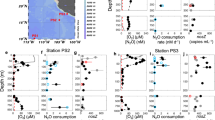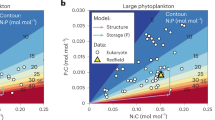Abstract
The rise of oxygenic photosynthesis nearly three billion years ago led to the accumulation of free oxygen and to the subsequent diversification of life on Earth; today, nearly half of all oxygen production derives from the photosynthetic activities of marine phytoplankton1. The conclusion that the open sea –– and therefore much of our planet's surface –– is in a net heterotrophic metabolic state2,3,4 is enigmatic and is a first-order question in the global carbon cycle, as discussed by del Giorgio and Duarte5. Our findings suggest that autotrophy in the open sea is episodic and decoupled from the more constant heterotrophic processes. Consequently, the metabolic balance of the open sea depends on proper space and timescale integration to achieve an ecological understanding of life in the sea.
Similar content being viewed by others
Main
Claims that the open ocean is in a net heterotrophic state run counter to results from other studies from these regions, including net carbon export to deep waters6 and net oxygen flux to the atmosphere7,8. How can we resolve this apparent paradox? A recently completed two-year experiment in the oligotrophic North Pacific (near 23° N, 158° W) showed net autotrophy to be variable over time, resulting in short-lived (days to weeks), aperiodic bursts of oxygen accumulation (Fig. 1).
a, Daily mean saturation of dissolved oxygen and nitrogen as a function of time from mooring-based measurements of total gas pressure and oxygen at a reference depth of 50 m. The aperiodic increases in oxygen, relative to nitrogen, indicate periods of net autotrophy. Changes in nitrogen saturation are due to temperature-induced changes in solubility and to air injection by bubble formation. The general increase in oxygen saturation from about March through to late summer — a minimum estimate of net production — is both intermittent within a given year and variable between years. b, c, Variations in temperature at 2 and 150 m from mooring-based measurements (continuous lines) compared with the approximately monthly ship-based measurements at common depths (crosses). These reference levels are selected to reveal periods of near-surface stratification (elevated temperatures at 2 m) and deep-water entrainment at the base of the euphotic zone (decreased temperatures at 150 m). The high-frequency (days to weeks) variations observed in both records are not well resolved in the ship-based data set, despite almost monthly occupations at this site.
Net heterotrophy is also time-variable, but to a much less extreme extent than net autotrophy, perhaps because of the structure of the microbial community or the dynamics of the separate resource pools. The net autotrophy events give rise to oxygen supersaturations in the range 2–4% at 50 m (Fig. 1). This is equivalent to a daily net oxygen production of 5–10 mmol m−3, about an order of magnitude greater than the 12-year mean production rate based on discrete monthly measurements at this time-series site9.
The relatively short lifetime and infrequent occurrence of these events combine to provide a temporal mosaic in the net metabolic state, one that is impossible to assess accurately on the basis of any single sampling (Fig. 1). For example, let us assume that the export ratio is 10%, the background respiration rate is 10% greater than the background rate of oxygen production, and the pulsed rate of oxygen production, which occurs 10% of the time, is three times the background rate: then, if the ecosystem is randomly sampled 1, 5 and 20 times, an observer conducting an oxygen-bottle experiment in vitro will incorrectly conclude that the system is net heterotrophic 89%, 55% and 33% of the time, respectively. This probable error in judgement is consistent with the published field results and the general lack of repeat observations. Geochemical techniques, with much longer integration timescales, properly incorporate both net autotrophic and net heterotrophic phases; this is the key to defining the true metabolic state of the sea.
The forcing mechanism(s) responsible for this intermittence in the metabolic state of the sea are not well understood. Although short-term changes in grazing and/or viral lysis could change plant biomass and affect net autotrophy, we currently favour a hypothesis of resource control by one or more novel mechanisms of inorganic nutrient delivery10,11,12 or possibly by the atmospheric deposition of iron13. These stochastic nutrient-loading processes can rapidly alter microbial community structure, decouple organic matter cycles, and lead to the high-frequency net autotrophy events at station ALOHA (Fig. 1). At present, no ocean observatory has an adequate measurement programme in place to detect these proposed events and therefore to assess the metabolic balance of the open sea. This is an important challenge for the future because accurate estimation and comprehensive understanding of the metabolic balance of the open sea have implications for the global carbon cycle and carbon sequestration processes.
References
Field, C. B., Behrenfeld, M. J., Randerson, J. T. & Falkowski, P. Science 281, 237–240 (1998).
del Giorgio, P. A., Cole, J. J. & Cimbleris, A. Nature 385, 148–151 (1997).
Duarte, C. M. & Agustí, S. Science 281, 234–236 (1998).
Duarte, C. M., Agustí, S., del Giorgio, P. A. & Cole, J. J. Science 284, 1735 (1999).
del Giorgio, P. A. & Duarte, C. M. Nature 420, 379–384 (2002).
Emerson, S. et al. Nature 389, 951–954 (1997).
Emerson, S., Quay, P. D., Stump, C., Wilbur, D. & Schudlich, R. J. Geophys. Res. 100, 15873–15887 (1995).
Najjar, R. G. & Keeling, R. F. Global Biogeochem. Cycles 14, 573–584 (2000).
Karl, D. M., Bidigare, R. R. & Letelier, R. M. in Phytoplankton Productivity and Carbon Assimilation in Marine and Freshwater Ecosystems (eds Williams, P. J. leB., Thomas, D. R. & Reynolds, C. S.) 222–264 (Blackwell, London, 2002).
McGillicuddy, D. J. Jr et al. Nature 394, 263–266 (1998).
Uz, B. M., Yoder, J. A. & Osychny, V. Nature 409, 597–600 (2001).
Gregg, M. C., Sanford, T. B. & Winkel, D. P. Nature 422, 513–515 (2003).
Young, R. W. et al. Global Biogeochem. Cycles 5, 119–134 (1991).
Author information
Authors and Affiliations
Corresponding author
Rights and permissions
About this article
Cite this article
Karl, D., Laws, E., Morris, P. et al. Metabolic balance of the open sea. Nature 426, 32 (2003). https://doi.org/10.1038/426032a
Issue Date:
DOI: https://doi.org/10.1038/426032a
This article is cited by
-
Change in rheotactic behavior patterns of dinoflagellates in response to different microfluidic environments
Scientific Reports (2021)
-
Extreme rates and diel variability of planktonic respiration in a shallow sub-arctic lake
Aquatic Sciences (2019)
-
Size fraction of phytoplankton and the contribution of natural plankton to the carbon source of Zhikong scallop Chlamys farreri in mariculture ecosystem of the Sanggou Bay
Acta Oceanologica Sinica (2017)
-
Both respiration and photosynthesis determine the scaling of plankton metabolism in the oligotrophic ocean
Nature Communications (2015)
-
Surface Water Metabolism Potential in Groundwater-Fed Coastal Waters of Hawaii Island, USA
Estuaries and Coasts (2014)
Comments
By submitting a comment you agree to abide by our Terms and Community Guidelines. If you find something abusive or that does not comply with our terms or guidelines please flag it as inappropriate.




